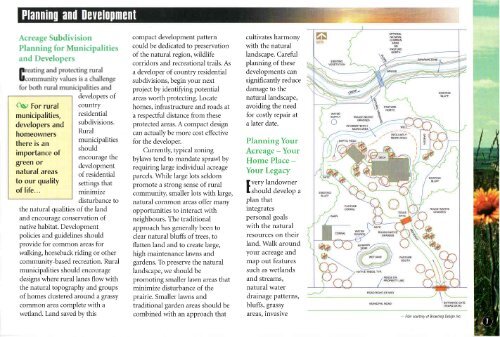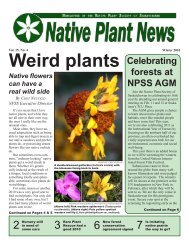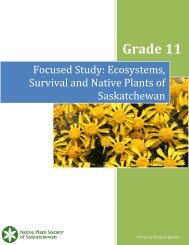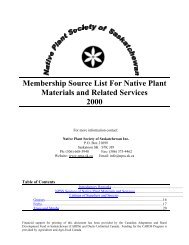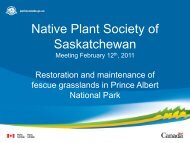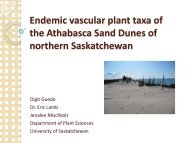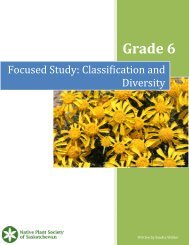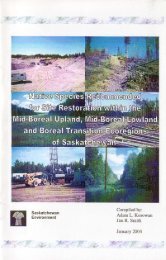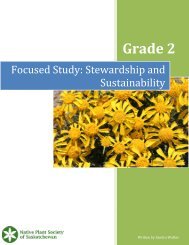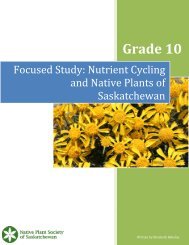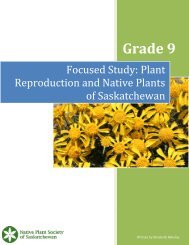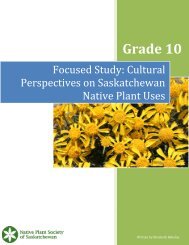Acreage Living - Native Plant Society of Saskatchewan
Acreage Living - Native Plant Society of Saskatchewan
Acreage Living - Native Plant Society of Saskatchewan
Create successful ePaper yourself
Turn your PDF publications into a flip-book with our unique Google optimized e-Paper software.
<strong>Acreage</strong> S division<br />
Planning for nicipalities<br />
and D lopers<br />
flreating<br />
and protecting<br />
developers <strong>of</strong><br />
For rural country<br />
municipalities, residential<br />
developers and subdivisions.<br />
Rural<br />
homeowners<br />
municipalities<br />
there is an<br />
should<br />
importance <strong>of</strong><br />
encourage the<br />
green or<br />
development<br />
natural areas <strong>of</strong> residential<br />
to our quality settings that<br />
<strong>of</strong> life...<br />
mlnlmze<br />
disturbance to<br />
rural<br />
compact development pattern cultivates harmony<br />
could be dedicated to preservation<br />
<strong>of</strong> the natural region, wildLife<br />
corridors and recreational trails. As<br />
with the natural<br />
landscape. Carefi,rl<br />
planning <strong>of</strong> these<br />
Ucommuniry values is a chalJenge<br />
a developer <strong>of</strong> country residential<br />
subdivisions, begin your next<br />
developments can<br />
significantly reduce<br />
for both rural municipalities and project by identifying potential damage to the<br />
areas worth protecting. Locate natural landscape,<br />
homes, infiastructure and roads at avoiding the need<br />
a respectful distance from these for costly repair at<br />
protected areas. A compact design<br />
can actually be more cost effective<br />
for the developer.<br />
CurrenLly, typical zoning<br />
bylaws tend to mandate sprawl by<br />
requiring large individual acreage<br />
parcels. While large lots seldom<br />
promote a strong sense <strong>of</strong> rural<br />
community, smaller lots with large,<br />
natural common areas <strong>of</strong>fer many<br />
opportunities to interact with<br />
a later date.<br />
PlanningYour<br />
reage - Your<br />
Home Place -<br />
Your Legacy<br />
Jvery<br />
neighbours. The traditional<br />
approach has generally been to<br />
clear natural bluffs <strong>of</strong> trees, to<br />
flatten land and to create large,<br />
high maintenance lawns and<br />
gardens. To preserve the natural<br />
landscape, we should be<br />
promoting smaller lawn areas that<br />
minimize disturbance <strong>of</strong> the<br />
prairie. Smaller lawns and<br />
traditional garden areas should be<br />
combined with an approach that<br />
landowner<br />
the natural qualities <strong>of</strong> the land<br />
lshould develop a<br />
plan that<br />
mtegrates<br />
and encourage conseration <strong>of</strong><br />
personal goals<br />
native habitat. Development<br />
with the natural<br />
policies and guidelines should<br />
resources on their<br />
provide for common areas for<br />
land. Walk around<br />
walking, horseback riding or other<br />
your acreage and<br />
community-based recreation. Rural<br />
map out features<br />
municipalities should encourage<br />
such as wetlands<br />
designs where rural lanes flow with<br />
and streams,<br />
the natural topography and groups<br />
natural water<br />
<strong>of</strong> homes clustered around a grassy<br />
drainage patterns,<br />
common area complete with a<br />
bluffs, grassy<br />
wetland. Land saved by this areas, lnvaslve<br />
Plan couftesy <strong>of</strong> Bnwning Design In.


